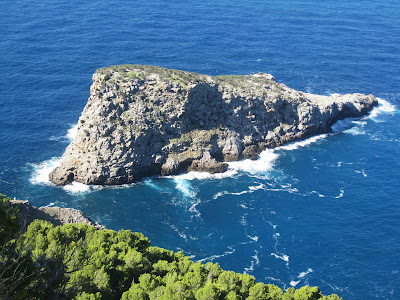 |
| Miro in the permanent exhibition at the railway station, Soller |
 |
| More Joan Miro |
 |
| Palma Cathedral - second largest in Europe |
 |
| Orient in the Serra de Tramuntana |
 |
| Cap de Formentera |
 |
| Badia de Pollenca |
 |
| s'Illeta |
 |
| Coast north of Port de Soller |
 |
| Puig Major, highest mountain and site of USA Radar Station |
 |
| Pollenca and another cycle race, the island is a cyclist's paradise |
 |
| Soller Market |
 |
| And the walking is pretty good too, Soller and Port de Soller from Serra de Alfabia |
 |
| Picasso pottery in Soller museum |
I had agreed to an extensive period of work in Shetland and we decided to take a holiday before I started. Aileen was keen to go somewhere warm and there was not much on offer. Much as we enjoy visiting Mediterranean islands, Mallorca had never been in my sights until someone bought me a walking guide to Majorca last Christmas. Maybe it was hearing about Magaluf and English breakfasts or just seeing those checking in for Palma at various airports. So with some trepidation, I made a late booking even by my standards to take a couple of weeks there in October. Apart from the weather which was much the same as Scotland but with thunderstorms, it exceeded our expectations. There was a common courtesy, good quality of accommodation and food and the scenery was quite outstanding and, being October, it had fewer visitors so it was possible to get about with ease.
We stayed the first night in a Finca high in the Serra de Tramuntana mountains and enjoyed the instinctive customer focus, fine food and stunning location. Several people had highlighted it as their special retreat on Trip Advisor and we could appreciate why. Then on to Pollenca, a pleasant working town close to the beaches but a good base for touring. After the first day when reading and swimming competed for time, the rains set in and we were limited to visiting places and testing the local restaurants which were universally good but quite expensive as were most things on the island compared to the UK. It was a remarkably relaxing place, even dawn seemed to be late with the cockerels crowing at 9am.
Trips to Arta, Formentor, Inca and Palma were made to save the mountains for week 2 when we moved to Fornalutz. Palma was clean, busy but easy-paced, full of street art and surprises as the townscape revealed its treasures. The cathedral was immense, the second tallest in Europe with flying buttresses and pillars so slim that structural engineers, if asked, would want scaffolding to be erected. Instead, they brought in Gaudi to modernise the interior which he did in his inimitable style.
The seascapes along the road to Formentor were quite amazing and for once I could enjoy the scenery as I was not driving. I had not managed to replace a stolen driving license in time; apparently, someone is hiring cars in France using my old license which disappeared from my passport at CDG airport back in the summer. At the end of a road which had more switchbacks than hatchbacks was the old lighthouse, a place for a snack and with spectacular coastal perspectives.
By the end of the week, we were ready to seek new locations and we headed into the Serre de Tramuntana mountains on switchback roads following a cycle race until we arrived at Lluc, a monastery in the mountains. And then over the highest roads and under Puig Major where the United States has constructed a massive radar station at the top and excluded the public from enjoying what would be the star attraction of the island. We arrived at Fornalutz, a village in the heart of the mountains but just a couple of miles walk from Soller and its Port.
Soller is a superbly located town with great facilities and a sense of place. It was first inhabited by the French but now hosts many Brits and Germans. The Soller railway station hosted exhibitions of the paintings of Miro and the pottery of Picasso, a free gallery which rewarded us with a couple of hours of amazement at a place on a human scale which seemed at one with the works on display. We left the exhibition elated whereas the big museum often leaves you jaded after tramping around collections which are too large and leave you feeling that you have missed the essence of the art.
The poor weather continued until a massive thunderstorm cleared the air. We visited Deia where the celebrities hang out and Valdemossa where Chopin wrote many of his works. We managed 3 days of walking in the high mountains and along the beautiful coast. The terrain was tough with limestone ridges fluted by water with the clints and grikes of the Karst topography requiring sure footwork. There is an alternative to the high tops, the GR221 which provides a 7-day walk through the mountains and utilises superb limestone paths constructed over many generations. But it is overrun by large groups of German happy wanderers singing, "Valderee Valderah ha ha ha ha ha" as they click their walking poles and swing their knapsacks on their way to the next refuge.
So altogether Mallorca proved a safe, well-organised, civilised, tourist-friendly island which could serve as an example to most British tourist haunts. It probably lacks the edginess of other islands but I can understand why it is full of domiciled British and German citizens.














No comments:
Post a Comment
thanks